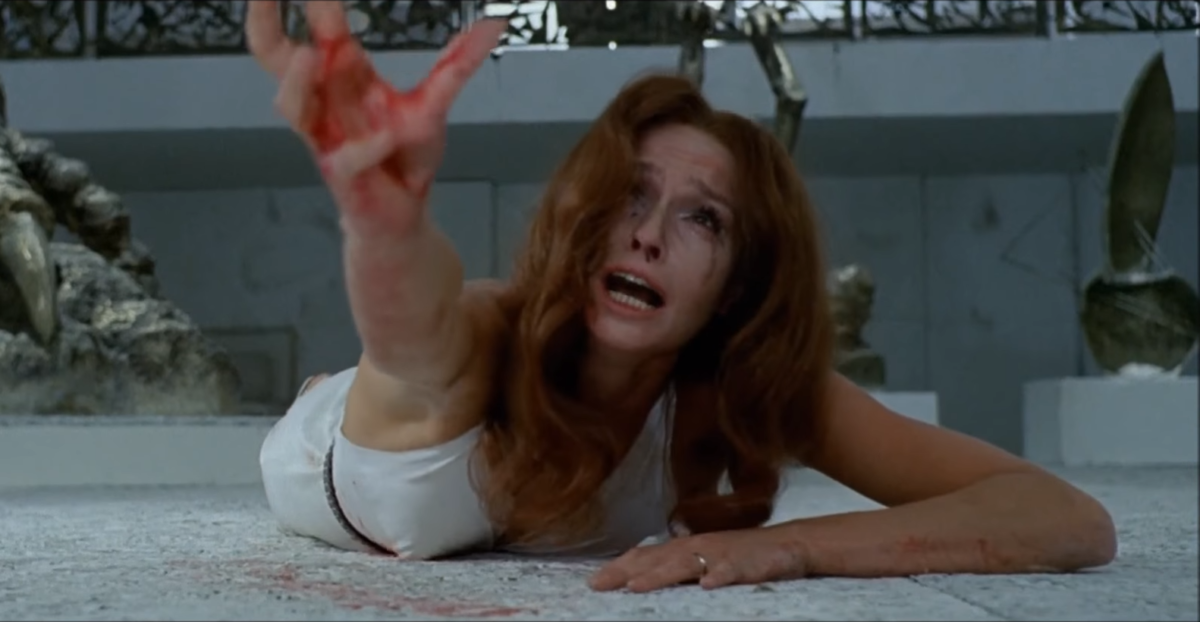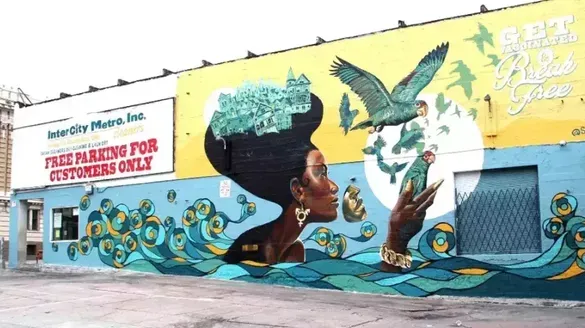The term ‘slasher’ refers to a formulaic horror subgenre that was first popularised in the late 1970s and early 1980s following the success of John Carpenter’s Halloween (1978) and Sean S. Cunningham’s Friday the 13th (1980). In sum, these films depict a group of fun-loving teens who are stalked and slashed to death, one by one, until the shadowy killer is revealed and subdued by the surviving female protagonist.
As sex, drugs and alcohol equals death, one might argue that the slasher film is nothing more than a conservative morality tale that rewards its survivor, otherwise known as the Final Girl, for her all-American wholeness. Yet consider that when slasher films were first popularised, America was recovering from the Vietnam War, complete with an enfeebled world position and a faltering economy, and the overall incompetence of the Carter administration was met by the rise of the New Right. Slasher films invite teen audiences to see themselves rebel against authority on screen and, just as the killer’s rampage provides audiences with a violent cathartic outlet, the Final Girl’s survival offers an image of resilience and hope.
Scream, written by Kevin Williamson and directed by Wes Craven, resurrected and updated the slasher’s socially reflective formula for the 1990s, using the theme of past family trauma as the trigger for a new generation of teens in peril. The 1996 original, along with subsequent sequels, also popularised a self-reflexive awareness of horror film conventions for their knowing, cine-literate audiences.
As the irrepressible film geek Randy (Jamie Kennedy) famously states in the original Scream, “there are certain rules that one must abide by in order to successfully survive a horror movie.” The ongoing success of the Scream franchise, which not only includes the fifth instalment of the film series but also the MTV series, is premised on the ability to recycle these rules to mirror the changing social, cultural and gendered preoccupations and anxieties of the cycle’s audience.
While the reproduction of this perennially popular but no less terrifying set of traits ensures that the slasher cycle will never die, these rules have also formed the basis of some of the most influential and intriguing slasher entries from across the decades:
1. The Bird With the Crystal Plumage (1970)
Long before terms such as ‘slasher’ had even entered popular cinema vocabulary, Italian filmmakers were creating a wave of ‘giallo’ or murder mystery hybrids that later North American cinema would draw upon. Dario Argento helped kickstart the Italian giallo craze with this compelling film of a foreign national implicated in a murderer’s rampage after witnessing a woman being brutally assaulted in a Rome art gallery. The resolution reveals that the art gallery ‘victim’ is in fact the film’s killer, establishing themes of gender ambiguity that later slasher titles would also focus on.
2. Black Christmas (1974)
Although its reputation is often eclipsed by the wider success of Halloween, Bob Clark’s 1974 film remains one of the slasher subgenre’s earliest and most disturbing entries. This Canadian release focuses on a deranged killer who terrorizes a group of college students whilst remaining concealed within the confines of their own sorority house. The film’s innovative use of point of view camerawork set the standard for subsequent slasher film techniques, whilst its thematic focus on an independent heroine seeking to extract herself from an overbearing partner reflected wider feminist concerns of the 1970s. Sophia Takal’s 2019 remake, which links gendered violence to an elite male sect, also indicates the slasher’s innovative take on the concept of toxic masculinity.
3. Halloween (1978)
John Carpenter’s landmark film was co-written and produced by Debra Hill. It applies the codes and conventions of Black Christmas and transforms its careerist college students into three small-town girlfriends, situating them in the widely recognisable suburbs of America. In so doing, Halloween captures the trials and tribulations of female youth in a post-feminist culture where, supposedly, the demands of feminism have been achieved and are no longer needed. However, when Michael Myers escapes Smith’s Grove Sanatorium and a violent disruption ensues, the idyllic comfort and safety of small-town America is brought into question, raising the continued prevalence of masculinised violence against women.
4. Friday the 13th (1980)
By July 1980, only three Hollywood films had been produced to capitalise on the success of John Carpenter’s film: Friday the 13th, Prom Night, and Terror Train (all 1980). Where Prom Night emphasised Halloween’s focus on female youth, Friday the 13th cast a large group of mix-sexed teens and relocated Halloween’s story structure to a summer camp. With scenes of light conversation, fun and games, flirting and sunbathing, drinking and smoking, Friday the 13th sought to capture a wider demographic that reflected its target audience. Through its focus on a past act of trauma enacted at the summer camp location, Friday the 13th also borrows from the Italian giallo with its use of elaborate set piece deaths that amplify gore, and an ambiguously gendered killer that is revealed to be a bereaved middle-aged mother.
5. My Bloody Valentine (1981)
Not all slasher films occur in overground suburban locations. The bulk of George Mihalka’s influential entry takes place in a coal mine, where company employees are apparently being dispatched by a vengeful worker left for dead in a Valentine’s Day pit accident. Through this plot device, this Canadian entry focuses on the socioeconomic triggers for vengeance, rather than the psychosexual motivations of the killer. Completed as part of the 1970s Tax Shelter funding scheme, My Bloody Valentine was the subject of extensive censorship and press censure for presenting scenes of violence that had effectively been financed by the Canadian taxpayer.
6. Halloween: The Curse of Michael Myers - AKA Halloween 6 (1995)
Very much like its unstoppable killer, the Halloween series remains the franchise that simply refuses to die. Joe Chapelle’s film belongs to a trio of films that original producer Moustapha Akkad completed between 1988 and 1995 to tap into the burgeoning trend of slasher sequels. The film added a ritualistic cult mythology to explain Michael Myers' indestructible nature. However, when the original print aired to test audiences, poor feedback resulted in the film’s distributor Dimension Pictures demanding substantial reshoots from Akkad and his creative team. Following this truncated release, fans of the franchise began to assemble excerpts of the original ‘Producer’s Cut’ that had begun to circulate unofficially online. This campaign of fan restoration was sustained for a considerable number of years, resulting in an eventual home entertainment release of the original cut in 2014. Whilst still an imperfect entry, this subsequent release indicates the increased impact that slasher fandom has over the film industry.
7. I Know What You Did Last Summer (1997)
Written by Kevin Williamson, I Know What You Did Last Summer is often criticised as a reductive cash-in of Scream, even though the film’s script predates it. Unlike Scream, I Know What You Did Last Summer is a much more traditional murder mystery in the style of early slasher films from the late 1970s and early 1980s, and focuses on a group of teenagers who conceal a hit and run accident. However, the film still maintains a self-reflexive edge that was a prerequisite for 1990s slasher entries. For example, Helen Shivers (Sarah Michelle Gellar) is chased and killed in an extended sequence that replicates the fate of Wendy (Anne-Marie Martin) in Prom Night, and the Final Girl (Jennifer Love Hewitt) even provides a psychoanalytic explanation when discussing serial killers, urban legends and morality tales at the beginning of the film.
8. Candyman (2021)
Adding a supernatural element to the slasher mythology, Nia DaCosta provides an acclaimed and intelligent sequel to Bernard Rose’s original film. Rose focused his 1992 release on the lethal legacy of Daniel Robitaille, whose brutal murder by a 19th century white mob unleashes the undead Candyman curse across the Cabrini-Green housing projects. DaCosta elaborates on the original’s themes of morbid romance and expands them into a cutting commentary around contemporary racial injustice, which sees a range of black male figures subjected to state violence after having wrongly been identified as the unstoppable killer. In so doing, DaCosta signals the importance of race traumas to the slasher film’s established preoccupations with gender, sexuality and class. The inclusion of original Candyman actor Tony Todd in the film’s closing scene also opens up the potential for further intriguing entries to the franchise.
Xavier Mendik is Professor of Cult Cinema Studies in the School of Games, Film and Animation at Birmingham City University, from where he also runs the Cine-Excess International Film Festival: www.cine-excess.co.uk. He is the author/editor/co-editor of ten books that deal with cult and horror film traditions.
Daniel Sheppard is an AHRC funded PhD candidate at Birmingham City University. His thesis focuses on gender and sexuality in the teen slasher subgenre. In August 2021, he co-organised The Slasher Studies Summer Camp: An International Conference on Slasher Theory, History and Practice.












